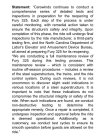July 12, 2023
Carowinds is currently in the process of removing the existing support column and replacing it with a new steel column fabricated by Bolliger & Mabillard (B&M), the ride manufacturer. This replacement requires meticulous preparation and detailed execution.
This afternoon, on July 12, cranes will be assembled to securely hold and position the track element of the coaster while removing the components of the existing column. Hydraulic jacks will assist in lifting the column out of its foundation. Once successfully removed, the column will be carefully transported to a secured backstage area of the park. Grout pockets will undergo thorough cleaning to prepare for the installation of the new column.
On Thursday, July 13, the new support column, along with hardware from B&M, will be delivered. Our skilled associates will diligently install the column, ensuring precise alignment and securely fastening the track/column connection. Following the completion of the column installation, an as-built survey will be conducted to accurately determine the elevations of the base plate.
Every step of the process, from material delivery to installation, will be carefully monitored and adjusted as necessary to uphold the integrity of the structure. Carowinds is fully committed to ensuring a seamless transition and maintaining the highest standards of safety and precision throughout the project.
Once the installation is complete, as part of our standard safety protocol, a comprehensive series of tests will be conducted to ensure the coaster's safety and integrity. These will include an accelerometer test that uses sensors to measure any variation in the ride experience. After that, we plan to operate the ride for 500 full cycles, performing tests and inspections of the entire ride throughout that period. Once this phase is completed, we will ask B&M and the third-party testing firm to perform a final inspection to ensure the ride exceeds all required specifications.
Subsequently, we will collaborate with the North Carolina Department of Labor's Elevator and Amusement Device Bureau to prepare Fury 325 for reopening. We will provide an update regarding the reopening date of the ride once it has been finalized.”

:quality(70)/cloudfront-us-east-1.images.arcpublishing.com/cmg/7YID4CN2BNBPNBRX2JKVHRT63Q.jpeg)
